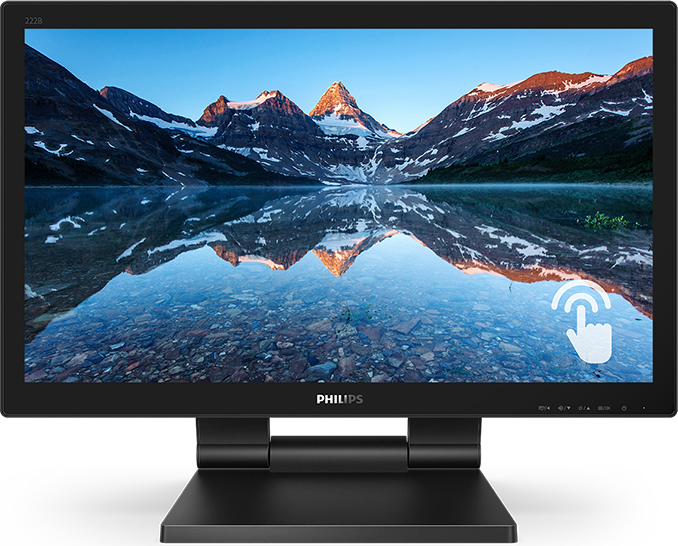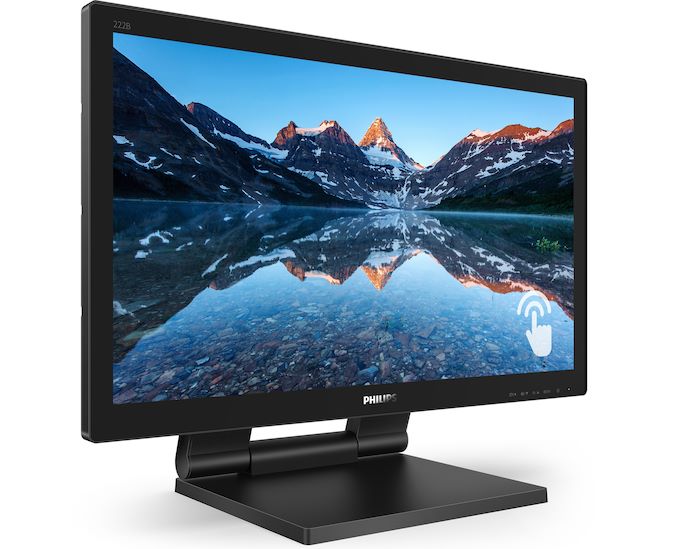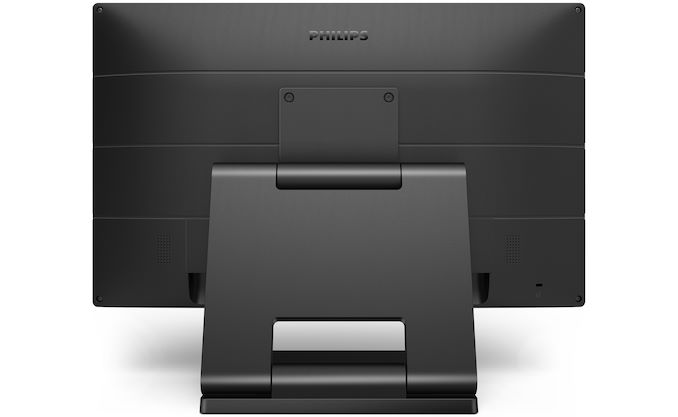Philips Launches 222B9T: A 21.5-Inch Semi-Rugged Monitor with Touch Support
by Anton Shilov on April 22, 2019 5:30 PM EST- Posted in
- Monitors
- Displays
- Philips
- Commercial

Taking a departure from the usual look-don't-touch world of PC monitors, Philips has rolled out a new, semi-rugged commerical monitor designed specifically for heavy touchscreen use. The Philips 222B9T is a 21.5-inch monitor with a 10-point capacitive touch system that's designed for use in commercial markets such as retail, point of sale, point of information, shops, restaurants, and education, incorporating several changes to ruggedize and otherwise reinforce the monitor and help it survive the harsh environment of human hands.
Under the hood, The 222B9T relies on a 21.5-inch TN panel featuring a 1920×1080 resolution, 250 nits brightness, a 1000:1 contrast ratio, a 60 Hz refresh rate, and 170°/160° viewing angles. The display features a 3H anti-glare coating as well as a W-LED backlighting. To make things look prettier, Philips has added a set of its technologies that adjust image quality, including such things as SmartContrast, EasyRead, Flicker-Free, and so on.
But the real story on the 222B9T isn't its admittedly low-end panel, bur rather everything else Phillips has added to it. Key to being a touch screen monitor, of course, is Phillips' projected capacitive (PCAP) 10-point multitouch technology, which gives the monitor its touch capabilities.The 222B9T then protects the capacitive layer by placing it under a thick pane of glass, which is essential for public use so that it can stand up to the rigors and abuses of public use. Philips has also insulated the monitor against water and dust, with the monitor offering IP54-class protection, which means that it's splash-resistant and dust-resistant as well.
Meanwhile the 222B9T monitor comes with a stand that can adjust its height and tilt so that to enable different usage scenarios. In terms of inputs, the monitor comes with DisplayPort, HDMI, DVI, and even D-Sub connections. Finally, the display has two 3W speakers (along with an audio input and a headphone output) and a dual-port USB 3.0 hub.
The monitor is available in Europe at a price of £239/€275, so expect it in other regions in the near future.
| Specifications of the Philips 222B9T Display | |
| Philips 222B9T | |
| Panel | 21.5" TN |
| Native Resolution | 1920 × 1080 |
| Maximum Refresh Rate | 60 Hz |
| Response Time | ? |
| Brightness | 250 cd/m² |
| Contrast | 1000:1 |
| Viewing Angles | 170°/160 horizontal/vertical |
| Color Gamut Support | sRGB: ? |
| Stand | Tilt and height adjustable |
| Inputs | 1 × DisplayPort 1 × HDMI 1 × D-Sub 1 × DVI |
| USB Hub | Dual-port USB 3.0 hub |
| Audio | 3 W × 2 audio input/output ports |
| Launch Price | £239/€275 |
Related Reading:
- Philips Brilliance 329P9H: A 4K IPS Monitor with USB-C Dock, GbE
- Philips Brilliance 499P9H Ultra-Wide 49-Inch Monitor Now Available
- Philips Unveils 43-Inch 4K Gaming LCD with DisplayHDR 1000, DCI-P3, FreeSync
- Philips Demos 328P8K: 8K UHD LCD with Webcam, Docking, Coming in 2018
Source: Philips












10 Comments
View All Comments
vFunct - Monday, April 22, 2019 - link
No idea why touch-screen monitors aren't more of a thing. Windows 10 is designed around it.jeremyshaw - Monday, April 22, 2019 - link
There usually tends to be a desk in the way.stephenbrooks - Monday, April 22, 2019 - link
The desk should be the touchscreenkhanikun - Tuesday, April 23, 2019 - link
Laziness. Why raise an arm up to touch the screen, when a slight flick of the wrist and a click will do the same thing. If this were a smaller screen, like 7", I'd buy it. Use it off to the side of my mouse for media controls.PeachNCream - Tuesday, April 23, 2019 - link
Touch for Windows was a Microsoft attempt to reach into the now shrinking tablet market back when it looked like a lucrative growth segment. It basically doesn't work in the PC/laptop usage model. Not many people are interested in reaching over interface devices they're already using quite efficiently to poke at and thusly gross-up their screens, nor do they want to pay extra for touch hardware or 2-in-1 units with hinge problems and non-useful touch capabilities. Even Microsoft is moving their Surface branding over to special purpose kiosk display systems and to conventional laptop hardware, forking away from consumer tablet-like systems.vFunct - Tuesday, April 23, 2019 - link
I have a touchscreen HP laptop, and use the touch screen all the time. Not for precision tasks, but for things like closing or opening windows.Trackpads on Windows laptops are terrible, and so touch-screen is so much better. And mouse pointers disappear on big desktops screens and takes a split second to figure out where they are, so it's easier and quicker to just touch certain elements.
PeachNCream - Tuesday, April 23, 2019 - link
I think you might be more of an exceptional case than the norm. I've seen lots of touch capable computers owned by people that never touch the screen or refused to do so because of they're disgusted by fingerprints and oily smearing. I'm one of the latter sorts. On a phone, something like that is no big deal because it's a quick wipe on a sleeve and you're good to go. On computers, fingerprints and goop are a whole different category of revolting. The fact that it doesn't bother you is a good thing, I think. I only wish I could tolerate a little bit of harmless oil, but I can't and I end up cleaning off my screen if I can identify anything on its surface.GreenReaper - Tuesday, April 23, 2019 - link
I agree, but I also think many consumers would benefit from TrackPoint-style input devices.niva - Wednesday, April 24, 2019 - link
Eww, you're one of those people with the dirty screens :(HollyDOL - Tuesday, April 23, 2019 - link
The idea of touch screens is pretty cool...In real though all touch screens I have seen so far looked like a bottom of trash can after a while. Dirt, grease, thumbprints everywhere...